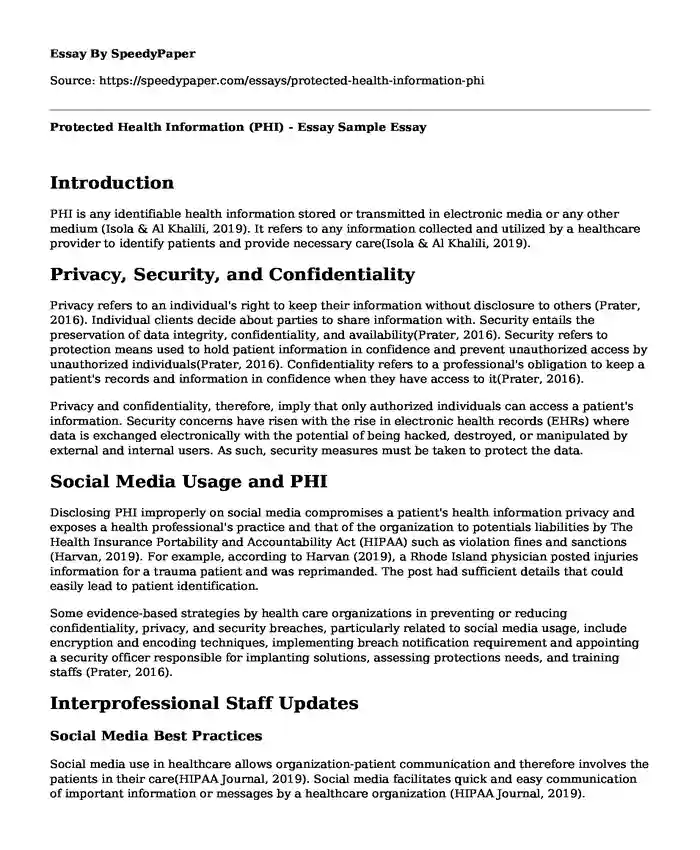
| Type of paper: | Essay |
| Categories: | Medicine Media Healthcare |
| Pages: | 3 |
| Wordcount: | 674 words |
Introduction
PHI is any identifiable health information stored or transmitted in electronic media or any other medium (Isola & Al Khalili, 2019). It refers to any information collected and utilized by a healthcare provider to identify patients and provide necessary care(Isola & Al Khalili, 2019).
Privacy, Security, and Confidentiality
Privacy refers to an individual's right to keep their information without disclosure to others (Prater, 2016). Individual clients decide about parties to share information with. Security entails the preservation of data integrity, confidentiality, and availability(Prater, 2016). Security refers to protection means used to hold patient information in confidence and prevent unauthorized access by unauthorized individuals(Prater, 2016). Confidentiality refers to a professional's obligation to keep a patient's records and information in confidence when they have access to it(Prater, 2016).
Privacy and confidentiality, therefore, imply that only authorized individuals can access a patient's information. Security concerns have risen with the rise in electronic health records (EHRs) where data is exchanged electronically with the potential of being hacked, destroyed, or manipulated by external and internal users. As such, security measures must be taken to protect the data.
Social Media Usage and PHI
Disclosing PHI improperly on social media compromises a patient's health information privacy and exposes a health professional's practice and that of the organization to potentials liabilities by The Health Insurance Portability and Accountability Act (HIPAA) such as violation fines and sanctions (Harvan, 2019). For example, according to Harvan (2019), a Rhode Island physician posted injuries information for a trauma patient and was reprimanded. The post had sufficient details that could easily lead to patient identification.
Some evidence-based strategies by health care organizations in preventing or reducing confidentiality, privacy, and security breaches, particularly related to social media usage, include encryption and encoding techniques, implementing breach notification requirement and appointing a security officer responsible for implanting solutions, assessing protections needs, and training staffs (Prater, 2016).
Interprofessional Staff Updates
Social Media Best Practices
Social media use in healthcare allows organization-patient communication and therefore involves the patients in their care(HIPAA Journal, 2019). Social media facilitates quick and easy communication of important information or messages by a healthcare organization (HIPAA Journal, 2019). Healthcare organizations also use social media to attract new patients.
Social media networks pose a high-risk factor for HIPAA rules violation and patient privacy violation. Organizations need a clear training and well-outlined policies to protect against HIPAA violation.
What not to Do: Social Media
Social media use in healthcare prohibits disclosure of protected health information(PHI) on social media channels (HIPAA Journal, 2019). Healthcare professionals should not disclose PHI on social media(HIPAA Journal, 2019). HIPAA privacy protocols restrict the use of PHI, such as patient's images that could easily lead to patient identification unless with the patient's consent(HIPAA Journal, 2019).
Social Media Risks to Patient Information
Social media may violate a patient's health information privacy and also expose health professionals to liabilities such as HIPAA violation fines. However, HIPAA has social media guidelines that guide social media use without violation of patient's privacy.
Steps to Take if a Breach Occurs
Covered entities are responsible for informing both the government and the patient about the breach (Moore & Frye, 2020). The patient must be notified within 60 days after identifying a breach. A breach of more than 500 patients involves informing media outlets in the state where the breach occurred within 60 days after the breach occurrence(Moore & Frye, 2020).
References
Harvan, A. C. (2019, October 10). HIPAA compliance in the social media age: What physicians should know | PAMED. PAMED | PAMED. https://www.pamedsoc.org/detail/article/hipaa-social-mediaTop of Form
HIPAA Journal. (2019, July 8). HIPAA social media rules. https://www.hipaajournal.com/hipaa-social-media/Isola, S., & Al Khalili, Y. (2019). Protected Health Information (PHI). In StatPearls [Internet]. StatPearls Publishing.
Moore, W., & Frye, S. (2020). Review of HIPAA, part 2: limitations, rights, violations, and role for the imaging technologist. Journal of Nuclear Medicine Technology, 48(1), 17-23. https://doi.org/10.2967/jnmt.119.227827
Prater, V. S. (2016). Confidentiality, privacy, and security of health information: Balancing interests. Article of Biomedical and Health Information Sciences, 4. https://doi.org/10.1016/b978-0-12-803135-3.00006-2
Cite this page
Protected Health Information (PHI) - Essay Sample. (2023, Dec 13). Retrieved from https://speedypaper.net/essays/protected-health-information-phi
Request Removal
If you are the original author of this essay and no longer wish to have it published on the SpeedyPaper website, please click below to request its removal:
- Essay Example about Cognitive Behavioral Therapy in the US
- Parkison's Disease Essay Example
- Free Essay Focusing on Literacy Programs for Oral Health Care for Older Adult
- Essay Sample on Causes of Teenage Pregnancy
- Summary of the Initiative. Free Essay
- Strategizing Team Building for Effective Management & Skill Specialization - Essay Sample
- Free Paper Sample on Critical Analysis of Structuralist Theory
Popular categories




